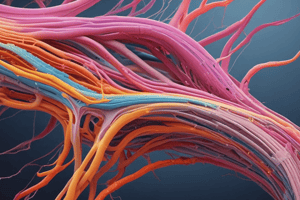Podcast
Questions and Answers
Which type of muscle fibers are primarily involved in endurance activities?
Which type of muscle fibers are primarily involved in endurance activities?
- Type 2X fibers
- Type 1 fibers (correct)
- Type 2B fibers
- Type 2A fibers
What is the correct order of recruitment for muscle fibers during increasing force demands?
What is the correct order of recruitment for muscle fibers during increasing force demands?
- Type 1, Type 2X, Type 2A
- Type 2A, Type 1, Type 2X
- Type 1, Type 2A, Type 2X (correct)
- Type 2X, Type 2A, Type 1
Which statement is true about the size principle of motor unit recruitment?
Which statement is true about the size principle of motor unit recruitment?
- Type 1 fibers are recruited first for low force demands. (correct)
- Type 2 fibers are always recruited before Type 1 fibers.
- Fiber recruitment is random and does not follow a specific pattern.
- Type 1 fibers are activated last during high force activities.
In highly trained individuals, which fibers can be recruited before Type 1 fibers?
In highly trained individuals, which fibers can be recruited before Type 1 fibers?
What is the primary reason for the transition of Type 2X fibers to Type 2A fibers through training?
What is the primary reason for the transition of Type 2X fibers to Type 2A fibers through training?
Flashcards are hidden until you start studying
Study Notes
Motor Unit Recruitment
- Muscles are activated by signals originating from the brain, which traverse along neurons and ultimately reach the muscle fibers. This intricate process involves electrical impulses, known as action potentials, that enable communication between the central nervous system and skeletal muscle, facilitating voluntary and involuntary movements.
- Muscles contain different types of fibers, each adapted to specific functional demands:
- Type 1 fibers, also known as slow-twitch fibers, are characterized by their ability to generate energy through aerobic metabolism, making them particularly efficient for prolonged activities. These fibers are smaller in size and possess a rich supply of blood vessels and mitochondria, allowing them to sustain endurance activities such as long-distance running or cycling with minimal fatigue.
- Type 2A fibers, classified as fast-twitch fibers, exhibit properties of both aerobic and anaerobic metabolism. They are larger than Type 1 fibers and are recruited during activities requiring moderate exertion such as running at a faster pace, swimming, or lifting weights. Additionally, Type 2A fibers provide a balance between power and endurance, making them versatile for athletes participating in various sports.
- Type 2X fibers, also fast-twitch but distinct from Type 2A, consist of large motor units and are primarily engaged in producing high levels of force for brief durations. These fibers rely predominantly on anaerobic metabolism, making them suitable for explosive movements such as sprinting, jumping, or heavy lifting. However, they fatigue quickly and are not ideal for sustained activity.
The Size Principle
- The recruitment of motor units adheres to a concept known as the size principle, which posits that motor units are activated in order of their size and the force demands of the task:
- During low-force activities, Type 1 fibers are preferentially recruited first due to their efficiency and endurance capacity, allowing for controlled, sustained movement.
- As the intensity of the activity increases and additional force is required, Type 2A fibers are recruited next. This transition enhances the ability to generate a moderate level of strength while maintaining some endurance.
- Finally, when maximal force production is necessary, Type 2X fibers are recruited last. Their activation allows for rapid, powerful bursts of strength but is accompanied by a significant increase in fatigue.
Selective Recruitment
- Individuals who undergo rigorous training, such as athletes or bodybuilders, can achieve a higher level of selective recruitment. This phenomenon enables these trained individuals to activate Type 2A and Type 2X fibers before engaging Type 1 fibers, which significantly enhances speed and power output during performance. The ability to skip the recruitment of Type 1 fibers can lead to quicker activation of muscle fibers, promoting efficiency in activities like sprinting and weightlifting, where rapid force production is critical.
Muscle Fiber Type and Function
- Different muscle groups in the human body possess varying percentages of these muscle fiber types, tailored to their specific functions:
- Muscles utilized for high-intensity activities such as sprinting and heavy lifting typically display a higher proportion of Type 2 fibers. This composition is advantageous as it facilitates greater force and power for explosive movements.
- In contrast, muscles that require fine motor control and prolonged endurance, such as the muscles in the eyes and those responsible for posture, primarily rely on Type 1 fibers. This reliance on slow-twitch fibers enhances their ability to perform continuous, precise actions without tiring easily.
All-Or-None Principle
- The all-or-none principle describes the behavior of each individual motor unit, which asserts that a motor unit is either fully activated or not activated at all. When an action potential reaches a motor neuron, it triggers the complete contraction of the muscle fibers within that motor unit. This ensures a consistent and reliable response in the muscle, crucial for effective movement.
Fiber Type Transition
- Adaptations through training can lead to physiological changes in muscle fiber types, notably allowing Type 2X fibers to transition into Type 2A fibers. This transformation enhances the fatigue resistance of the muscle, as Type 2A fibers possess a greater capacity for aerobic energy production compared to their Type 2X counterparts. Consequently, this transition can result in improved overall performance in endurance-based activities while maintaining strength capabilities.
Studying That Suits You
Use AI to generate personalized quizzes and flashcards to suit your learning preferences.




